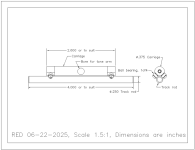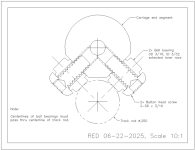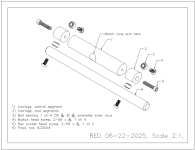Balls running on tracks strikes me as very complicated! I can certainly appreciate the ease of minimizing the friction with this approach, but here are challenges I foresee:
- How to keep the balls contained? I envision losing them rather easily. This might not be a problem for me, but most likely would be for my son.
- How to reposition them into their "home" position for the next record?
- How to ensure the tracks are straight and smooth?
- How to minimize the weight of the carriage tracks?
Are there simple solutions to these issues? Or, am I misunderstanding something?
- How to keep the balls contained? I envision losing them rather easily. This might not be a problem for me, but most likely would be for my son.
- How to reposition them into their "home" position for the next record?
- How to ensure the tracks are straight and smooth?
- How to minimize the weight of the carriage tracks?
Are there simple solutions to these issues? Or, am I misunderstanding something?
Paul, i am pleased to see you have started to think about this idea.
I have mentioned before that i started out with contained recirculating ball bearings and then moved on to non recirculating.
It was a significant improvement for me, so worth exploring those questions you ask.
To start with i was not familiar with the idea and it seemed more difficult to grasp, but as soon as I had done a prototype all that went away.
I think there are simple answers to all your questions.
Carlo has decades of experience in constructing all sorts of tone arms, he answered my similar question to yours, saying, don't worry, the balls don't run around like out of control animals, they behave according to the laws and stay in place.
I have done many hundreds of experiments now, with different configurations and played many hundreds of discs with this type of traveller and i have never once displaced the balls or found them out of position, they simply quietly get on with the task and stay correctly placed.
How to keep them in position? - they sit naturally in the tracks/channels and are contained at the ends by the end stops, see my post 5512, in the second and third photos i positioned the balls at the two ends of the travel on the carriage.
They will progress to these positions each time.
On the rails a simple end stop avoids them falling out the ends and is the limit of travel of the carriage.
So simply put the balls on the rails, each towards one extremity, put the carriage on top and move the carriage by hand to the two extremities. the balls will then automatically find their correct positions because the end stops will push/skid them along, from then on they will stay in place naturally, and as previously mentioned i have never seen them misbehave.
This type of carriage or the ball bearing type could just possibly be knocked off its tracks by careless or inexperienced handling, and either type could have a keeper ring attached to the carriage and encircling the rails if you wished.
I have never done that and never had a problem, and this is no different to handling a PTA, one could easily drop or knock the end, but it doesn't happen in practice.
Straight and smooth tracks is the same question for any type, non recirc., BB's or jewelled wheels.
I currently use two stainless rods glued side by side, which i selected, ground and polished by hand, having also used simple bought in anodised angle, which was a very good start point. The rods are perhaps more rigid, the angle more simple.
For the carriage a small piece of angle as shown in those pics, cost a few cents and ground to size, because here the smallest angle i can obtain is 10-12mm, and this is around 5mm. It is very light, and overall weight of the carriage will not be a problem. i expect the moving weight of these designs to be between 30 and 60gms and this carriage runner is less than 5 of those.
So, this is a simple practical solution with many advantages, well worth exploring.
I am happy to answer anything you like, or take some pics or videos for you.
My ramblings are found on these threads over time. Different people who post, approach things in different ways, at one extreme there are those who simply pose questions or ideas but don't build real life items, then there are those with good theory and science, and then people like me who have practical knowledge and ideas and build things to experiment and use. Early on i said i would not be a continuous experimenter, i just wanted to build something for use, however that changed into concepts and build of different types, testing and measuring to confirm or dispel my ideas!
Post 5514 shows a diagram of the forces at work as a record plays, and this lead me to a different solution than the wand - but that's another story.....
I have mentioned before that i started out with contained recirculating ball bearings and then moved on to non recirculating.
It was a significant improvement for me, so worth exploring those questions you ask.
To start with i was not familiar with the idea and it seemed more difficult to grasp, but as soon as I had done a prototype all that went away.
I think there are simple answers to all your questions.
Carlo has decades of experience in constructing all sorts of tone arms, he answered my similar question to yours, saying, don't worry, the balls don't run around like out of control animals, they behave according to the laws and stay in place.
I have done many hundreds of experiments now, with different configurations and played many hundreds of discs with this type of traveller and i have never once displaced the balls or found them out of position, they simply quietly get on with the task and stay correctly placed.
How to keep them in position? - they sit naturally in the tracks/channels and are contained at the ends by the end stops, see my post 5512, in the second and third photos i positioned the balls at the two ends of the travel on the carriage.
They will progress to these positions each time.
On the rails a simple end stop avoids them falling out the ends and is the limit of travel of the carriage.
So simply put the balls on the rails, each towards one extremity, put the carriage on top and move the carriage by hand to the two extremities. the balls will then automatically find their correct positions because the end stops will push/skid them along, from then on they will stay in place naturally, and as previously mentioned i have never seen them misbehave.
This type of carriage or the ball bearing type could just possibly be knocked off its tracks by careless or inexperienced handling, and either type could have a keeper ring attached to the carriage and encircling the rails if you wished.
I have never done that and never had a problem, and this is no different to handling a PTA, one could easily drop or knock the end, but it doesn't happen in practice.
Straight and smooth tracks is the same question for any type, non recirc., BB's or jewelled wheels.
I currently use two stainless rods glued side by side, which i selected, ground and polished by hand, having also used simple bought in anodised angle, which was a very good start point. The rods are perhaps more rigid, the angle more simple.
For the carriage a small piece of angle as shown in those pics, cost a few cents and ground to size, because here the smallest angle i can obtain is 10-12mm, and this is around 5mm. It is very light, and overall weight of the carriage will not be a problem. i expect the moving weight of these designs to be between 30 and 60gms and this carriage runner is less than 5 of those.
So, this is a simple practical solution with many advantages, well worth exploring.
I am happy to answer anything you like, or take some pics or videos for you.
My ramblings are found on these threads over time. Different people who post, approach things in different ways, at one extreme there are those who simply pose questions or ideas but don't build real life items, then there are those with good theory and science, and then people like me who have practical knowledge and ideas and build things to experiment and use. Early on i said i would not be a continuous experimenter, i just wanted to build something for use, however that changed into concepts and build of different types, testing and measuring to confirm or dispel my ideas!
Post 5514 shows a diagram of the forces at work as a record plays, and this lead me to a different solution than the wand - but that's another story.....
Hello Paul,
As promised, I found my design of a theoretical linear tone arm carriage. I made up some PNGs for you to look at.
If you don't use the ideas, I won't be offended. If you are going to use my ideas, feel free to make changes. The carriage could be made as a single component, and its cross section could be square rather than cylindrical. The bores in the ball bearings are .09375" in diameter but the screws are .086" in diameter, requiring a shim liner to make up the difference. You could use metric bearings and screws because it would be easier to get matching diameters.
If someone designed a similar carriage in the past, my apologies,
Ralf



As promised, I found my design of a theoretical linear tone arm carriage. I made up some PNGs for you to look at.
If you don't use the ideas, I won't be offended. If you are going to use my ideas, feel free to make changes. The carriage could be made as a single component, and its cross section could be square rather than cylindrical. The bores in the ball bearings are .09375" in diameter but the screws are .086" in diameter, requiring a shim liner to make up the difference. You could use metric bearings and screws because it would be easier to get matching diameters.
If someone designed a similar carriage in the past, my apologies,
Ralf



The track rod is only 4" long? I would think it would need to be at least 8" (4" of grooves + 2" on each side for the carriage). What have you found to work best for the bearings? Dry / lubricated, sealed / open, ceramic or metal?
I think I'm going to start with Colin's original design (as close as I can replicate it) and see how well it works. I may also do some experiments with the ball and track approach as an alternative / backup.
I think I'm going to start with Colin's original design (as close as I can replicate it) and see how well it works. I may also do some experiments with the ball and track approach as an alternative / backup.